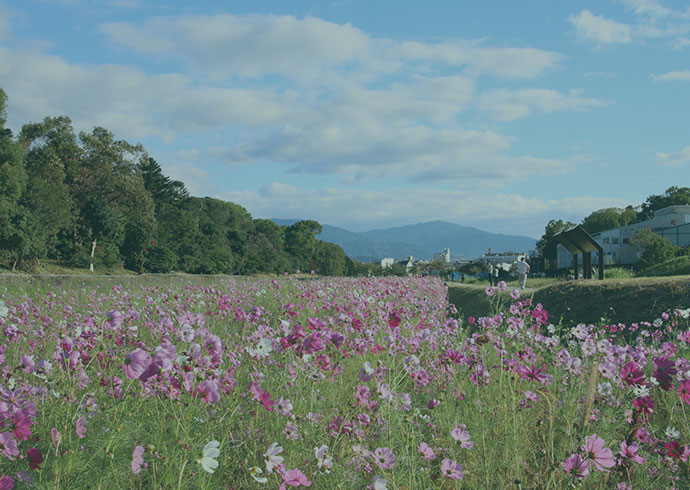Sightseeing spots

- TOP
- Sightseeing spots
- Minegazuka Kofun
See
Minegazuka Kofun



It is a keyhole-shaped tumulus with a mound length of 96m. Although it is not a particularly large burial mound among the Furuichi Kofun Group, it has a double moat on the outside of the mound. The burial mound was built in two stages, and the foot of the upper slope was covered with fukiishi.
During the excavation in 1991, many burial goods were found in the newly confirmed stone chamber near the top of the round part of the mound. Among them, there are a total of more than 3,500 items, such as large swords with decorations such as silver and deer horn, military burial goods, and silver flower decorations used as decorations.
Other sightseeing spots 「See」
the Mausoleum of Emperor Ojin
This is the central burial mound of the “Mozu-Furuichi Kohun Group”, which was registered as a World Heritage Site in 2019.

See
Konda Hachimangu Shrine
Konda Hachimangu Shrine attracts those who feel deeply connected to Emperor Ojin

See
Habikino City Cultural Property Exhibition Room
You can appreciate a wide variety of haniwa.

See
Takenouchi-kaido
Japan’s oldest national highway "Takenouchi‐Kaido" certified as a Japan Heritage

See
the Hakuchoryo Mausoleum
"Hakuchoryo Mausoleum" is said to be the tomb of Yamato Takeru no Mikoto. If you look at the burial mound through Shugo, you can see a magnificent view.

See
Hakayama Kofun
It is a large keyhole-shaped tumulus with a mound length of 225m.

See
Yuryaku-tenno-ryo Kofun
The Shimaizumi-maruyama Tumulus with a diameter of 75m and the Shimaizumi-hiratsuka Tumulus with a side length of 50m are arranged in a circular shape.

See
Tsudo-shiroyama Kofun and Museum "Mahora Shiroyama"
Built in the latter half of the 4th century, it is the oldest large keyhole-shaped burial mound in the Furuichi Kofun Group.

See
Chuai-tenno-ryo Kofun
It is the third largest large keyhole-shaped mounded tomb in the Furuichi Kofun Group.

See
AICEL-Shura Hall
On the second floor of the building with motifs of boat-shaped haniwa and Shura, there is a historical exhibition zone that displays excavated artifacts.

See
Ninken-tenno-ryo Kofun
Among the Furuichi Kofun Group, it is a burial mound that has the characteristics of a new period.

See
Habikino Local Cafe Bikkino
The official cafe of "Habikino Burger", a local burger made from Habikino City’s specialty products.

Buy
See
Eat
Morimoto Shrine
In the past, an imperial envoy was dispatched from the Imperial Court, and it boasted prosperity as a highly prestigious Myojin Taisha.

See
Hachibuseyama Nishimine Kofun
An ancient burial mound located on Mt. Hachibuseyama.

See
Sairinji Temple
It is one of the oldest temples in Minamikawachi, founded in the Asuka period by the Kawachi no Fumiuji clan, who were immigrants.

See
Tsukiyomi Bridge
Stone lanterns used to serve as guides, and have been used as signposts along the Takenouchi-Kaido since ancient times.

See
Daikokuji Temple
An old temple of Zen Buddhism whose principal image is Daikokuten, said to be the oldest in Japan.

See
Asukabe Shrine
The shrine is said to have enshrined King Konki of the Kudara royal family, the ancestor of the Asukabe clan, an immigrant clan.

See
Tsuhoji Temple Ruins
It is said that in 1043, the Senju Kannon statue found by Minamoto no Yoriyoshi of Kawachi Genji was enshrined.

See
Tomb of Genji three generations
Minamoto no Yorinobu, who was appointed Kawachi no kami in the middle of the 11th century, Yorinobu's son Yoriyoshi, and grandson Yoshiie are buried here.

See
Kannonzuka Kofun
It used to be a vineyard, but it was designated as a national historic site in 1981, and you can see the inside of the Yokoguchi-style stone wall.

See
Yoshimura Family's Residence
A representative house of a wealthy farmer in the early modern period, which is designated as an important cultural property of the country.

See
Myokyoji Temple
According to the temple legend, it was built as Phoenix Temple at the request of Emperor Suiko, and after being exposed to fire many times, it was rebuilt by Toyotomi Hideyoshi.

See
Otsu Shrine
Known as "Tange no Sato no Omiya" and "Kawachi no Omiya", it was revered as the tutelary deity of the surrounding nine villages.

See
Yachuji Temple
It is said to have been built by Soga no Umako on the orders of Prince Shotoku. The precincts are nationally designated historic sites, and there is a bodhisattva designated as an important cultural property.

See
Hatada Family's Residence
It is an old family house located in Kozu, Habikino City, and the layout of the mansion and interior design convey the flavor of the Meiji period. [City designated cultural property]

See